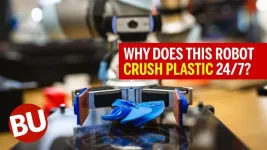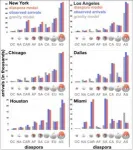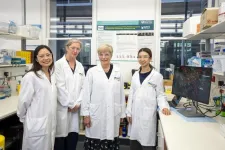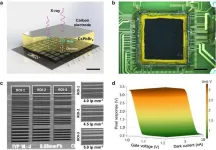(Press-News.org) Inside a lab in Boston University’s College of Engineering, a robot arm drops small, plastic objects into a box placed perfectly on the floor to catch them as they fall. One by one, these tiny structures—feather-light, cylindrical pieces, no bigger than an inch tall—fill the box. Some are red, others blue, purple, green, or black.
Each object is the result of an experiment in robot autonomy. On its own, learning as it goes, the robot is searching for, and trying to make, an object with the most efficient energy-absorbing shape to ever exist.
To do this, the robot creates a small plastic structure with a 3D printer, records its shape and size, moves it to a flat metal surface—and then crushes it with a pressure equivalent to an adult Arabian horse standing on a quarter. The robot then measures how much energy the structure absorbed, how its shape changed after being squashed, and records every detail in a vast database. Then, it drops the crushed object into the box and wipes the metal plate clean, ready to print and test the next piece. It will be ever-so-slightly different from its predecessor, its design and dimensions tweaked by the robot’s computer algorithm based on all past experiments—the basis of what’s called Bayesian optimization. Experiment after experiment, the 3D structures get better at absorbing the impact of getting crushed.
These experiments are possible because of the work of Keith Brown, an ENG associate professor of mechanical engineering, and his team in the KABlab. The robot, named MAMA BEAR—short for its lengthy full title, Mechanics of Additively Manufactured Architectures Bayesian Experimental Autonomous Researcher—has evolved since it was first conceptualized by Brown and his lab in 2018. By 2021, the lab had set the machine on its quest to make a shape that absorbs the most energy, a property known as its mechanical energy absorption efficiency. This current iteration has run continuously for over three years, filling dozens of boxes with more than 25,000 3D-printed structures.
Why so many shapes? There are countless uses for something that can efficiently absorb energy—say, cushioning for delicate electronics being shipped across the world or for knee pads and wrist guards for athletes. “You could draw from this library of data to make better bumpers in a car, or packaging equipment, for example,” Brown says.
To work ideally, the structures have to strike the perfect balance: they can’t be so strong that they cause damage to whatever they’re supposed to protect, but should be strong enough to absorb impact. Before MAMA BEAR, the best structure anyone ever observed was about 71 percent efficient at absorbing energy, says Brown. But on a chilly January afternoon in 2023, Brown’s lab watched their robot hit 75 percent efficiency, breaking the known record. The results have just been published in Nature Communications.
“When we started out, we didn’t know if there was going to be this record-breaking shape,” says Kelsey Snapp (ENG’25), a PhD student in Brown’s lab who oversees MAMA BEAR. “Slowly but surely we kept inching up, and broke through.”
The record-breaking structure looks like nothing the researchers would have expected: it has four points, shaped like thin flower petals, and is taller and narrower than the early designs.
“We’re excited that there’s so much mechanical data here, that we’re using this to learn lessons about design more generally,” Brown says.
Their extensive data is already getting its first real-life application, helping to inform the design of new helmet padding for US Army soldiers. Brown, Snapp, and project collaborator Emily Whiting, a BU College of Arts & Sciences associate professor of computer science, worked with the US Army and went through field testing to ensure helmets using their patent-pending padding are comfortable and provide sufficient protection from impact. The 3D structure used for the padding is different from the record-breaking piece—with a softer center and shorter stature to help with comfort.
MAMA BEAR is not Brown’s only autonomous research robot. His lab has other “BEAR” robots performing different tasks—like the nano BEAR, which studies the way materials behave at the molecular scale using a technology called atomic force microscopy. Brown has also been working with Jörg Werner, an ENG assistant professor of mechanical engineering, to develop another system, known as the PANDA—short for Polymer Analysis and Discovery Array—BEAR to test thousands of thin polymer materials to find one that works best in a battery.
“They’re all robots that do research,” Brown says. “The philosophy is that they’re using machine learning together with automation to help us do research much faster.”
“Not just faster,” adds Snapp. “You can do things you couldn’t normally do. We can reach a structure or goal that we wouldn’t have been able to achieve otherwise, because it would have been too expensive and time-consuming.” He has worked closely with MAMA BEAR since the experiments began in 2021, and gave the robot its ability to see—known as machine vision—and clean its own test plate.
The KABlab is hoping to further demonstrate the importance of autonomous research. Brown wants to keep collaborating with scientists in various fields who need to test incredibly large numbers of structures and solutions. Even though they already broke a record, “we have no ability to know if we’ve reached the maximum efficiency,” Brown says, meaning they could possibly break it again. So, MAMA BEAR will keep on running, pushing boundaries further, while Brown and his team see what other applications the database can be useful for. They’re also exploring how the more than 25,000 crushed pieces can be unwound and reloaded into the 3D printers so the material can be recycled for more experiments.
“We’re going to keep studying this system, because mechanical efficiency, like so many other material properties, is only accurately measured by experiment,” Brown says, “and using self-driving labs helps us pick the best experiments and perform them as fast as possible.”
Republishers are kindly reminded to uphold journalistic integrity by providing proper crediting, including a direct link back to the original source URL.
END
3D printing robot uses AI machine learning for US Army research
See how an autonomous robot created a shock-absorbing shape no human ever could—and what it means for designing safer helmets, packaging, car bumpers, and more
2024-05-21
ELSE PRESS RELEASES FROM THIS DATE:
Ruptured Achilles tendon shows faster repair amid plasma irradiation treatment
2024-05-21
What is the largest ligament in the human body? It might surprise some people that it is the Achilles tendon. Even though it is also considered the toughest ligament, the Achilles tendon can rupture, with many such injuries involving sports enthusiasts in their 30s or 40s. Surgery might be required, and a prolonged period of rest, immobilization, and treatment can be difficult to endure.
Seeking to shorten the recovery time, a research team led by Osaka Metropolitan University Graduate School of Medicine’s Katsumasa Nakazawa, a graduate student in the Department of Orthopedic Surgery, Associate Professor ...
Screen time not the main factor making parent-child interactions worse, study finds
2024-05-21
Technology use is at an all-time high and understanding how this impacts daily life is crucial. When it comes to parent-child interactions, scientists have coined the term ‘technoference,’ meaning technology interference. It occurs when parent-child interaction and communication are disrupted by the use of digital devices.
But is distraction caused by digital devices more detrimental to parent-child interaction than when parental distraction comes from different sources? Researchers in Switzerland have investigated.
“In this study, we show that ...
Improving the effectiveness of earthquake early warning systems
2024-05-21
Mobile phones have become invaluable for receiving emergency alerts such as weather warnings, evacuation notices and notifications about missing persons. In Japan, where earthquakes are frequent, they are vital for delivering earthquake warnings and advising people to take protective actions beforehand. To deal with such situations promptly, the Earthquake Early Warning (EEW) system sends out notifications to areas expected to experience strong tremors by detecting primary seismic waves (P-waves) that arrive before the secondary waves (S-waves). However, the short time between receiving the notification and the arrival of S-waves ...
Addressing homelessness in older people
2024-05-21
Homelessness doesn’t only happen to young people but also affects older adults in growing numbers, write authors in an analysis in CMAJ (Canadian Medical Association Journal) that describes this emerging crisishttps://www.cmaj.ca/lookup/doi/10.1503/cmaj.231493.
People experiencing homelessness are considered older adults at age 50, as visible aging is often evident at younger ages in individuals experiencing homelessness compared with individuals who have secure housing. Individuals experiencing homelessness often develop chronic ...
One in 5 adults in Canada without access to primary care
2024-05-21
More than 1 in 5 adults in Canada did not have access to primary care, with large regional gaps in access, found new research in CMAJ (Canadian Medical Association Journal) https://www.cmaj.ca/lookup/doi/10.1503/cmaj.231372.
“Translated to the population of Canada, our survey estimates that more than 6.5 million adults across the country don’t have access to a family doctor or nurse practitioner they can see regularly,” says Dr. Tara Kiran, a family physician and researcher at the MAP Centre for Urban Health Solutions at St. Michael’s Hospital, Unity Health Toronto and the University ...
Studies on risks of weight-loss drugs and more presented at Digestive Disease Week
2024-05-21
Washington (May 14, 2024) — Studies examining the risks of GLP-1 weight-loss drugs, distinguishing alpha-gal syndrome from other GI disorders, and comparing medications to slow the progression of liver disease in patients with alcohol-use disorder will be presented this week at Digestive Disease Week (DDW) 2024. Abstracts are available to registered media. Embargos lift at 12:01 a.m. EDT on the day they are presented.
Here are summaries of the new research:
Re-examining the risks of gastrointestinal adverse events associated with glucagon-like peptide-1 receptor agonists for weight loss with more stringent criteria on a comprehensive ...
Pancreatic cancer research receives $8m philanthropic funding boost
2024-05-21
An exceptional $8 million, 10-year philanthropic investment will spearhead new treatments for pancreatic cancer and create a new dedicated research centre at WEHI.
The centre, to be established thanks to an investment by Australian business leader and WEHI President Jane Hemstritch AO, aims to help close the significant survival gap between pancreatic cancer and other cancers.
The Hemstritch Centre of Excellence for Pancreatic Cancer Research will provide a leading team of scientists and clinicians with long-term funding to ask big research questions. They aim to make major ...
'Hunting for treasures' with AI: Astronomers detect rare neutral atomic-carbon absorbers with deep neural network
2024-05-21
Recently, an international team led by Prof. GE Jian from the Shanghai Astronomical Observatory of the Chinese Academy of Sciences conducted a search for rare weak signals in quasar spectral data released by the Sloan Digital Sky Survey III (SDSS-III) program using deep learning neural networks. By introducing a new method to explore galaxy formation and evolution, the team showcased the potential of artificial intelligence (AI) in identifying rare weak signals in astronomical big data. This study was published ...
Researchers develop perovskite X-ray detector for medical imaging
2024-05-21
Technology (SIAT) of the Chinese Academy of Sciences, in collaboration with researchers at Central China Normal University, have developed a high-performance perovskite X-ray complementary metal-oxide-semiconductor (CMOS) detector for medical imaging.
The study was published in Nature Communications on Feb. 21.
X-ray imaging is vital for the diagnosis and treatment of cardiovascular and cancer diseases. Direct-conversion X-ray detectors made of semiconductor materials exhibit superior spatial and temporal resolution at lower radiation doses compared to indirect-conversion detectors made of scintillator materials. However, the currently available semiconductor ...
Rice chemist Gustavo Scuseria wins 2024 Schrödinger Medal
2024-05-21
By Jade Boyd
Special to Rice News
Pioneering Rice University chemist Gustavo Scuseria has won the 2024 Schrödinger Medal from the World Association of Theoretical and Computational Chemists.
Awarded annually to a single recipient, the medal recognizes an outstanding body of work in theoretical and computational chemistry. Scuseria has pioneered quantum computational methods that are widely used to study the complex quantum states and electronic properties of a wide range of molecules and materials. In awarding the medal, ...
LAST 30 PRESS RELEASES:
Can community awareness campaigns in low-resource areas improve early diagnosis of colorectal cancer?
Stardust study resets how life’s atoms spread through space
Practical education: Clinical scenario-based program development
The impact of family dynamics on eating behaviour – how going home for Christmas can change how you eat
Tracing the quick synthesis of an industrially important catalyst
New software sheds light on cancer’s hidden genetic networks
UT Health San Antonio awarded $3 million in CPRIT grants to bolster cancer research and prevention efforts in South Texas
Third symposium spotlights global challenge of new contaminants in China’s fight against pollution
From straw to soil harmony: International team reveals how biochar supercharges carbon-smart farming
Myeloma: How AI is redrawing the map of cancer care
Manhattan E. Charurat, Ph.D., MHS invested as the Homer and Martha Gudelsky Distinguished Professor in Medicine at the University of Maryland School of Medicine
Insilico Medicine’s Pharma.AI Q4 Winter Launch Recap: Revolutionizing drug discovery with cutting-edge AI innovations, accelerating the path to pharmaceutical superintelligence
Nanoplastics have diet-dependent impacts on digestive system health
Brain neuron death occurs throughout life and increases with age, a natural human protein drug may halt neuron death in Alzheimer’s disease
SPIE and CLP announce the recipients of the 2025 Advanced Photonics Young Innovator Award
Lessons from the Caldor Fire’s Christmas Valley ‘Miracle’
Ant societies rose by trading individual protection for collective power
Research reveals how ancient viral DNA shapes early embryonic development
A molecular gatekeeper that controls protein synthesis
New ‘cloaking device’ concept to shield sensitive tech from magnetic fields
Researchers show impact of mountain building and climate change on alpine biodiversity
Study models the transition from Neanderthals to modern humans in Europe
University of Phoenix College of Doctoral Studies releases white paper on AI-driven skilling to reduce burnout and restore worker autonomy
AIs fail at the game of visual “telephone”
The levers for a sustainable food system
Potential changes in US homelessness by ending federal support for housing first programs
Vulnerability of large language models to prompt injection when providing medical advice
Researchers develop new system for high-energy-density, long-life, multi-electron transfer bromine-based flow batteries
Ending federal support for housing first programs could increase U.S. homelessness by 5% in one year, new JAMA study finds
New research uncovers molecular ‘safety switch’ shielding cancers from immune attack
[Press-News.org] 3D printing robot uses AI machine learning for US Army researchSee how an autonomous robot created a shock-absorbing shape no human ever could—and what it means for designing safer helmets, packaging, car bumpers, and more







